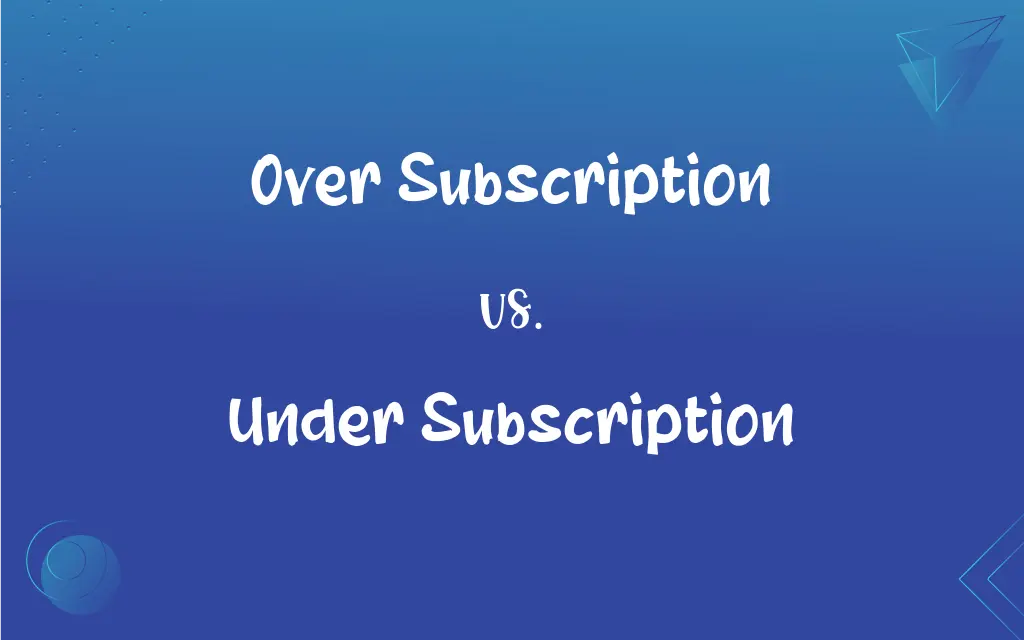Over Subscription vs. Under Subscription: What's the Difference?
Edited by Janet White || By Harlon Moss || Published on November 28, 2023
Over-subscription occurs when demand exceeds supply; under-subscription is when supply exceeds demand.

Key Differences
Over-subscription refers to a situation where the demand for a product, service, or investment exceeds its available supply. This often leads to a competitive allocation process. In contrast, under-subscription happens when the available supply of a product, service, or investment is greater than the demand for it, which can result in surplus or wasted resources.
In the context of finance, over-subscription is common during initial public offerings (IPOs) or bond issues, where investor interest exceeds the number of shares or bonds available. This can drive up the price. On the other hand, under-subscription in such scenarios indicates low investor interest, potentially leading to a drop in value or cancellation of the offering.
In services like web hosting, over-subscription implies that the provider has sold more resources (like bandwidth) than what is actually available, banking on the fact that not all users will use their maximum allotment simultaneously. Conversely, under-subscription in this context would mean resources are underutilized, often leading to inefficiencies.
For events or memberships, over-subscription can result in overcrowding or a waitlist, as more people want to attend or join than there is space available. Under-subscription in such cases indicates low turnout or interest, which can affect the viability and success of the event or organization.
In educational settings, over-subscription to a course or program means more students have applied than there are spots available, necessitating a selection process. Under-subscription, however, suggests a lack of interest or applicants, which might lead to the cancellation of the course or program.
ADVERTISEMENT
Comparison Chart
Demand vs. Supply
Demand exceeds supply
Supply exceeds demand
Financial Implications
Often leads to higher value/prices
May result in lower value/prices
Resource Allocation
Inefficient or competitive use
Inefficient or wasted resources
Impact on Services
Can lead to overcrowding/waitlists
Results in underutilization
Investor/Consumer Interest
High interest or competition
Low interest or lack of engagement
ADVERTISEMENT
Over Subscription and Under Subscription Definitions
Over Subscription
Allocating more resources than physically available, as in network bandwidth.
The internet service provider's over-subscription of bandwidth led to slow speeds during peak hours.
Under Subscription
Underutilization of allocated resources, as in a service.
The cloud service faced under-subscription, resulting in unused server capacity.
Over Subscription
Selling more shares or bonds than available in an IPO.
The company's IPO was over-subscribed within hours of opening.
Under Subscription
Selling fewer shares or bonds than available in an offering.
The bond issue was under-subscribed, raising less capital than anticipated.
Over Subscription
Higher enrollment requests than capacity in schools or courses.
Due to over-subscription, the school had to introduce a lottery system for admissions.
Under Subscription
Lower enrollment than capacity in educational programs.
The course was under-subscribed, leading to its eventual cancellation.
Over Subscription
More applications received than places available.
The university faced over-subscription for its popular computer science program.
Under Subscription
Fewer applications than places available.
The workshop faced under-subscription, with many seats remaining empty.
Over Subscription
Excess demand for a product or service.
The over-subscription of the concert tickets caused a frenzy among fans.
Under Subscription
Insufficient demand for a product or service.
The under-subscription of the new phone model led to excess inventory.
FAQs
What is over-subscription?
Excess demand over available supply in a product, service, or investment.
What causes over-subscription?
High demand, limited supply, or competitive pricing.
How do companies manage over-subscription?
Through allocation methods like lotteries, first-come-first-served, or merit-based selection.
Is over-subscription common in IPOs?
Yes, especially for popular or highly anticipated offerings.
What causes under-subscription?
Low demand, high supply, or lack of marketing.
Does under-subscription indicate poor quality?
Not necessarily; it may reflect market conditions or awareness issues.
Can over-subscription affect service quality?
Yes, it can lead to resource strain and reduced service quality.
How does over-subscription affect investors?
It can lead to higher returns but also increases competition for assets.
Does over-subscription benefit companies?
Initially yes, but it can harm reputation if not managed well.
How can under-subscription be prevented?
Through accurate market assessment, effective marketing, and pricing strategies.
How do companies respond to under-subscription?
They may reduce prices, improve marketing, or cancel the offering.
Can over-subscription lead to price increases?
Often, due to high demand and competition.
What is under-subscription?
When the demand for a product, service, or investment is less than the available supply.
What are the risks of over-subscribing a service?
Overload, reduced performance, and customer dissatisfaction.
Are there legal concerns with over-subscription?
In some cases, especially if it leads to unfair practices or breaches of contract.
What are the implications of under-subscription for companies?
Potential financial losses, reduced investor confidence, and strategic reassessment.
Does under-subscription affect stock prices?
It can lead to a decrease in stock value or market confidence.
Is under-subscription always negative?
Mostly, but it can also signal market saturation or shifting consumer preferences.
Is under-subscription a concern in education?
Yes, it can lead to course cancellations or resource inefficiency.
Can under-subscription be a strategic decision?
Rarely, as it usually indicates a lack of interest or miscalculation.
About Author
Written by
Harlon MossHarlon is a seasoned quality moderator and accomplished content writer for Difference Wiki. An alumnus of the prestigious University of California, he earned his degree in Computer Science. Leveraging his academic background, Harlon brings a meticulous and informed perspective to his work, ensuring content accuracy and excellence.
Edited by
Janet WhiteJanet White has been an esteemed writer and blogger for Difference Wiki. Holding a Master's degree in Science and Medical Journalism from the prestigious Boston University, she has consistently demonstrated her expertise and passion for her field. When she's not immersed in her work, Janet relishes her time exercising, delving into a good book, and cherishing moments with friends and family.






































































